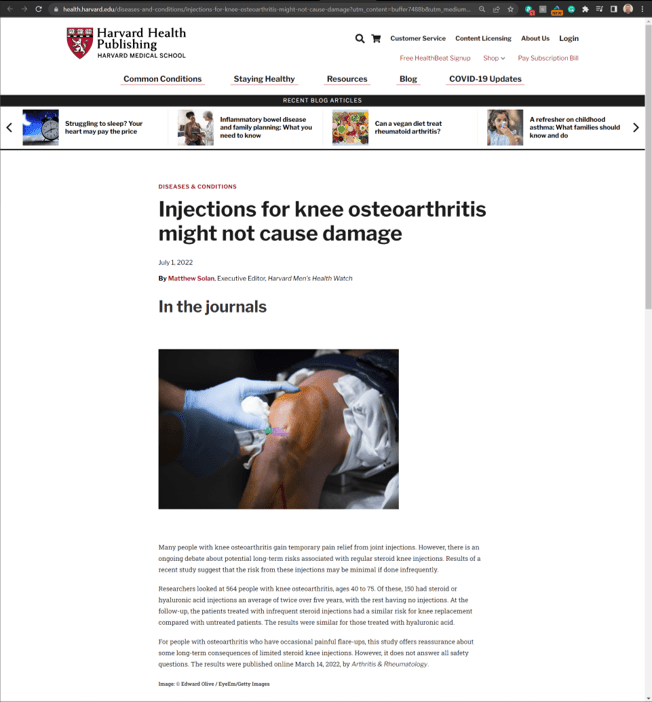Playing With Knee Steroid Data, Et Tu Harvard?
A few years back a seminal paper was published showing what many physicians knew was an issue, that mega-dose steroids destroy knee cartilage (1). However, this was a HUGE problem for many physicians who have been injecting this stuff with wild abandon for many years. Hence, it was only a matter of time before papers would be published to counter that idea. Let’s dive into a new research investigation, which seems to show that steroids aren’t half bad after all, but the research suffers from a SEVERE simple math problem.

Credit: Shutterstock
To Anyone Not Asleep at the Wheel Steroids are Toxic
It’s our job as physicians to become students of the evolving literature. What I mean by that, is that we’re supposed to be paying attention to what gets published and trying to divine how that impacts what we offer patients. However, that’s a full-time job in and of itself. For example, that’s why this blog exists. It was a way for me 15 years ago to force myself to keep up on the important stuff being published.
The data on how milligram dose steroids negatively impact patients has been clear for decades (1-15). Study after study was published using animal models and human cells that milligram dose corticosteroids destroyed everything from cartilage to tendons. Then human data began to show us that injecting this stuff before a joint replacement dramatically increased infection and prosthesis failure rates. Or injecting steroids before a rotator cuff surgery increased retear rates. Other data was published showing that steroids make problems like elbow epicondylitis worse. Then finally a large randomized controlled trial was published showing that in knee arthritis patients, steroid shots killed off the cartilage and didn’t even work well to reduce pain (1).
Hence, for anyone paying attention, it’s been clear for a long time that you shouldn’t be injecting this stuff into your patients. However, that doesn’t mean that all physicians who were paying attention liked this memo. All of a sudden, a monkey wrench of monumental proportions got thrown into their world. They had to accept that what they were doing day in and day out was likely causing harm to their patients. In fact, the more they ignored the obvious signs in the literature for decades that these injections were bad news, the more agitated they were when the consensus flipped. Hence, it was only a matter of time before the status quo tried to take a swipe back at the new anti-steroid message.
Harvard, Steroid Deniers, and Bad Data
We would all love to believe that elite universities can do no wrong. However, they are just as entrenched in all of the medical care we know doesn’t work as anybody else. Take for example a blog that I published showing that the Cleveland Clinic was still increasing the number of meniscectomy surgeries long after the publications of large RCTs demonstrated that this procedure didn’t work. The same just happened with steroid knee injections. However, this time it’s Harvard and by dissecting this recent highlighted publication, we can also learn a bit about how to critically review research.
The new research was featured on the very trusted Harvard Men’s Health Watch:

The researchers looked at 564 middle-aged and elderly people with knee arthritis (16). Of these, 150 had steroid or hyaluronic acid (HA or knee gel) injections about twice a year over five years, with the rest of the patients having no injections. The authors concluded that patients treated with infrequent twice-a-year steroid injections had a similar risk for knee replacement compared with untreated patients. However, the data they presented to support that conclusion is problematic at best.
First, as shown above, this paper was highlighted by the Harvard Men’s Health newsletter. Despite this being a lower level research study (retrospective case series and comparison) than what we already have published (prospective RCTs), at no time did the Harvard writer mention all of the research on steroids that show problems. In fact, there’s an even bigger issue, apparently, at Harvard, this writer never took a basic stats course. Let’s pull this new research apart to see why.
The biggest problem with a study like this is that only a small number of patients will convert to knee replacement over the period that you’re watching. For example, here, only 59 out of 564 patients went on to get a knee replacement over that time (about 10%). This is a serious problem, as 414 patients didn’t get any injections and 99 got HA injections, leaving only 51 patients who got steroid injections. While the authors don’t report how many converted to knee replacement in these groups, we know that this is about 10%. That means we’re comparing a paltry 5 patients who got knee steroid injections and who had a knee replacement. That number is compared to only 10 patients who had knee HA injections and needed a knee replacement. That steroid/knee replacement number is so low that this is a SEVERE study limitation. Meaning that if the abstract of the study had read, “There were 5 patients who had a TKA (knee replacement) and who received corticosteroid Injections…” every reviewer would have laughed as that number would need to be dozens to have any statistical significance. By hiding that number, the authors were likely able to razzle dazzle reviewers. How did they do that?
Like many similar studies, this one hides this data problem in the stats. Complex statistics are used, but nowhere in this paper is it obvious that there are severe limitations of this data. Meaning when all you have is the results of 5 patients, a random result from one or more patients can change the conclusions of the study. For example, if you had 30 patients that had steroids and then needed a knee replacement, if one or two random patients don’t fit the mold, you still have a stable study result. In fact, that’s the most basic concept in statistics, you need big enough numbers to make sure the effect you’re observing is not random. Hence, the stats for this paper should have begun and ended at, “We just don’t have a big enough n of patients who converted to knee replacement in the steroid group to reach any conclusion”.
The authors then slap more lipstick on this pig by trying to look at the x-ray changes in knee arthritis patients (KL grades) over this time period. The problem here is twofold: excluding the patients with the most change and no MRI.
Our stats happy authors state, “We excluded from this analysis patients who underwent TKR during the 5-year follow-up period…” Hence, our authors just tilted the playing field in the favor of steroids by excluding the 59 patients who were the most impacted. They also removed all severe arthritis patients, who were also the most likely to be impacted, leaving only half of the patients.
The other problem is that the New England Journal of Medicine RCT mentioned above clearly showed that the amount of cartilage being lost was at the rate of millimeters per year in the steroid group, hardly enough to change a knee x-ray severity grade during this study in the 5 patients that were tracked (1). So the fact that no MRIs were taken of these patients also likely hides what was likely happening in the small steroid group.
The upshot? We have lots of high-level research showing that steroid injections are bad news. This retrospective study with a grand total of 5 patients who were injected with steroids and converted to knee replacement is not a credible analysis on which a physician should base the continuation of this deleterious medical treatment.
__________________________________________________________________
References:
(1) McAlindon TE, LaValley MP, Harvey WF, et al. Effect of Intra-articular Triamcinolone vs Saline on Knee Cartilage Volume and Pain in Patients With Knee Osteoarthritis: A Randomized Clinical Trial. JAMA.2017;317(19):1967–1975. doi: 10.1001/jama.2017.5283
(2) Wijn SRW, Rovers MM, van Tienen TG, Hannink G. Intra-articular corticosteroid injections increase the risk of requiring knee arthroplasty. Bone Joint J. 2020 May;102-B(5):586-592. doi: 10.1302/0301-620X.
(3) Richardson SS, Schairer WW, Sculco TP, Sculco PK. Comparison of Infection Risk with Corticosteroid or Hyaluronic Acid Injection Prior to Total Knee Arthroplasty. J Bone Joint Surg Am. 2019 Jan 16;101(2):112-118. doi: 10.2106/JBJS.18.00454.
(4) Kang SS, Hwang BM, Son H, Cheong IY, Lee SJ, Chung TY. Changes in bone mineral density in postmenopausal women treated with epidural steroid injections for lower back pain. Pain Physician. 2012 May-Jun;15(3):229-36.
(5) Ravi B, Escott BG, Wasserstein D, Croxford R, Hollands S, Paterson JM, Kreder HJ, Hawker GA. Intraarticular hip injection and early revision surgery following total hip arthroplasty: a retrospective cohort study. Arthritis Rheumatol. 2015 Jan;67(1):162-8. doi: 10.1002/art.38886.
(6) Chon JY, Moon HS. Salivary cortisol concentration changes after epidural steroid injection. Pain Physician. 2012 Nov-Dec;15(6):461-6.
(7) STEINBROCKER O, EHRLICH ME, SILVER M, SICHER W, BERKOWITZ S, CARP S, FEISTEIN H. The clinical application of cortisone and ACTH in arthritis and related conditions: methods and problems. II: Side effects complications, contraindications, precautions and conclusions. Ariz Med. 1951 Sep;8(9):29-35.
(8) Brånemark PI, Goldie I. Observations on the action of prednisolone tertiary buryl acetate (Codelcortone TBA) and methylprednisolone acetate (depomedrone) on normal soft tissues. Acta Rheumatol Scand. 1967;13(4):241-56.
(9) Wang BL, Sun W, Shi ZC, et al. Decreased proliferation of mesenchymal stem cells in corticosteroid-induced osteonecrosis of femoral head. Orthopedics. 2008;31(5):444. doi:10.3928/01477447-20080501-33
(10) Bonnevialle N, Bayle X, Projetti F, Wargny M, Gomez-Brouchet A, Mansat P. Variations of the micro-vascularization of the greater tuberosity in patients with rotator cuff tears. Int Orthop. 2015;39(2):371‐376. doi:10.1007/s00264-014-2628-z
(11) Murray RC, DeBowes RM, Gaughan EM, Zhu CF, Athanasiou KA. The effects of intra-articular methylprednisolone and exercise on the mechanical properties of articular cartilage in the horse. Osteoarthritis Cartilage. 1998;6(2):106‐114. doi:10.1053/joca.1997.0100
(12) Habib GS. Systemic effects of intra-articular corticosteroids. Clin Rheumatol. 2009;28(7):749‐756. doi:10.1007/s10067-009-1135-x
(13) Dean BJ, Franklin SL, Murphy RJ, Javaid MK, Carr AJ. Glucocorticoids induce specific ion-channel-mediated toxicity in human rotator cuff tendon: a mechanism underpinning the ultimately deleterious effect of steroid injection in tendinopathy?. Br J Sports Med. 2014;48(22):1620‐1626. doi:10.1136/bjsports-2013-093178
(14) Cimino AM, Veazey GC, McMurtrie JT, et al. The Effect of Corticosteroid Injections on Clinical Outcomes and Failure Rates after Rotator Cuff Repair: A Systematic Review [published online ahead of print, 2020 May 7]. Arthroscopy. 2020;S0749-8063(20)30379-0. doi:10.1016/j.arthro.2020.04.044
(15) Wijn SRW, Rovers MM, van Tienen TG, Hannink G. Intra-articular corticosteroid injections increase the risk of requiring knee arthroplasty. Bone Joint J. 2020;102-B(5):586‐592. doi:10.1302/0301-620X.102B5.BJJ-2019-1376.R1
(16) Latourte A, Rat AC, Omorou A, Ngueyon-Sime W, Eymard F, Sellam J, Roux C, Ea HK, Cohen-Solal M, Bardin T, Beaudreuil J, Guillemin F, Richette P. Do Glucocorticoid Injections Increase the Risk of Knee Osteoarthritis Progression Over 5 Years? Arthritis Rheumatol. 2022 Mar 14. doi: 10.1002/art.42118. Epub ahead of print. PMID: 35289131.

If you have questions or comments about this blog post, please email us at [email protected]
NOTE: This blog post provides general information to help the reader better understand regenerative medicine, musculoskeletal health, and related subjects. All content provided in this blog, website, or any linked materials, including text, graphics, images, patient profiles, outcomes, and information, are not intended and should not be considered or used as a substitute for medical advice, diagnosis, or treatment. Please always consult with a professional and certified healthcare provider to discuss if a treatment is right for you.